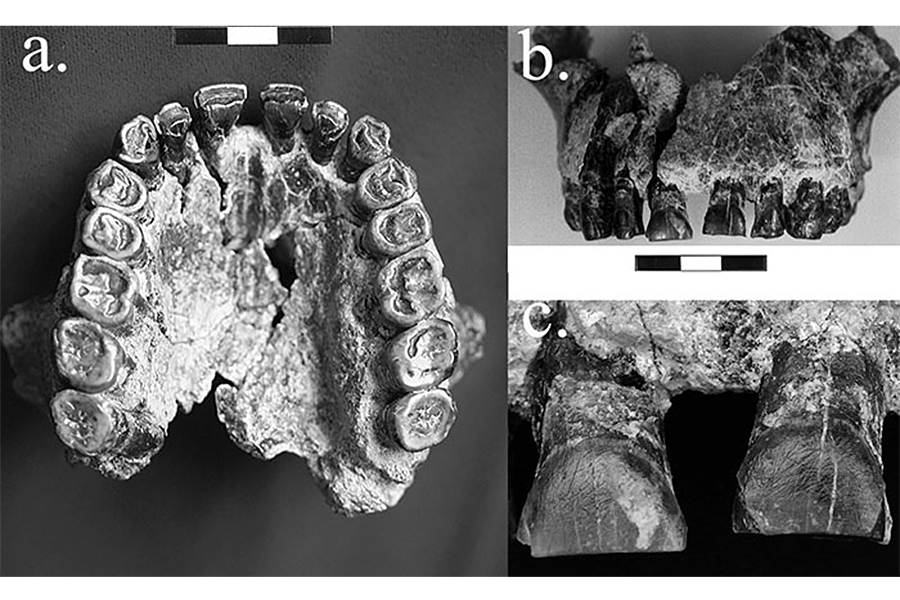Scientists say they have found the oldest right-handed human
Loading...
Nine out of every 10 people dominantly use their right hands, but most animals don't appear to have a handedness.
Little is known about the origins of handedness, but researchers say they have found the earliest right-handed person, and it's not a Homo sapiens.
An H. habilis who lived in what is now Tanzania some 1.8 million years ago appears to also have favored his or her right hand, according to new research published Thursday in the Journal of Human Evolution.
Until this study, the earliest evidence of right-handedness appeared in Neanderthals and their earlier relatives from about 430,000 years ago, Debra Guatelli-Steinberg, an anthropologist at Ohio State University who was not part of the study, explains. "This is an exciting paper because it strongly suggests right-handed tool use in early Homo around 1.8 million years ago."
But how can researchers figure out from just bones if an individual was right or left-hand dominant, or if they were handed at all?
David Frayer, a paleoanthropologist and professor emeritus at the University of Kansas, had noticed distinctive scratches on the teeth of the H. habilis fossil when it was first described over a decade ago. These grooves are on the lip-side face of the early human's front teeth and most of them appear to be slanting downward from left to right as if something had been dragged down across them from the right.
Dr. Frayer, along with an international team of colleagues, decided to take a closer look at what might have created these marks. They found that the scratches were consistent with those left on mouth guards in experiments where subjects used their teeth as a sort of "third hand" while cutting meat or another tough material.
The scenario goes something like this: The early human had to hold tough meat in place to cut it up into smaller pieces that were easier to chew, so held one end of the meat in their left hand and the other with their front teeth. Then, with his or her right hand, the individual sliced at the meat using a sharp stone tool. But when the right hand slipped, the tool would have scraped across the person's front teeth, leaving predominantly diagonal grooves much like those spotted by Frayer and his colleagues.
When the first H. habilis fossils were found, the species was dubbed "handy man" because, at the time, it was thought to be the first stone tool maker. "It's interesting that 'handy man' was handed," Frayer says with a laugh in an interview with The Christian Science Monitor.
Bernard Wood, a paleoanthropologist at George Washington University who was not part of the study, cautions that Frayer and his colleagues might be jumping to conclusions too quickly. "My concern is that they really don't spend enough time on other explanations for these phenomena, the presence of these scratches and their directionality," Dr. Wood says in a phone interview with the Monitor. "It's a really interesting observation that only time will tell whether that observation has been over-interpreted."
Frayer points out that the team tallied 559 marks on the teeth and almost 47 percent align with what would be expected to be produced by this right-handed behavior. In contrast, he says, just about 11 percent appear to have been produced by a left-handed cutting motion.
Still, this is just one individual H. habilis, and Wood says the findings would be more profound if found in a population of the species.
Dr. Guatelli-Steinberg agrees. "While [this] specimen indicates right-handed tool use, we will need larger samples from early Homo to assess the frequency of handedness in these hominins—that is the more interesting question from the standpoint of understanding how far back the modern human predilection for right-hand use can be pushed back into time," she writes in an email to the Monitor.
If researchers were to find evidence of handedness in more H. habilis fossils, that could perhaps tell them something about the evolution of this trait.
Neanderthals appear to have a ratio of lefties to righties similar to that in H. sapiens populations, but scientists aren't sure how that came to be. And while some evidence has suggested that chimpanzees, the closest living relatives of modern humans, display handedness, their population seems to be more evenly split by which hand is dominant in an individual, Frayer says.
Some researchers have suggested that handedness arose out of a restructuring of the brain (which they also say led to the rise of language) that happened in early humans and their relatives. If that is so, Frayer suggests, then finding evidence of handedness in H. habilis could help researchers confirm that correlation.
Still, with just one individual, this study will likely just provide a framework and a nudge for a closer look at other early human fossils, says Frayer. "It's the beginning of a picture more than the final snapshot."









